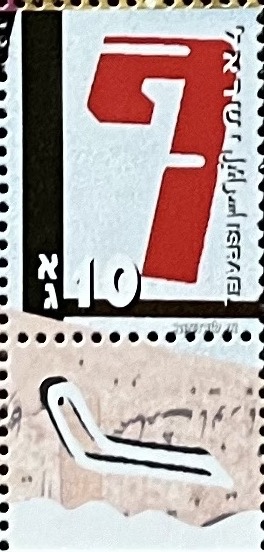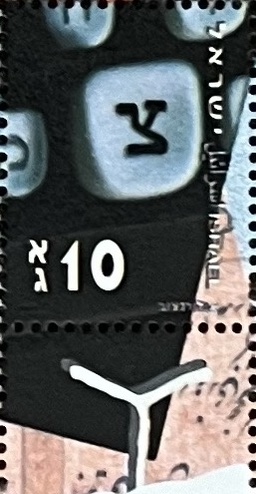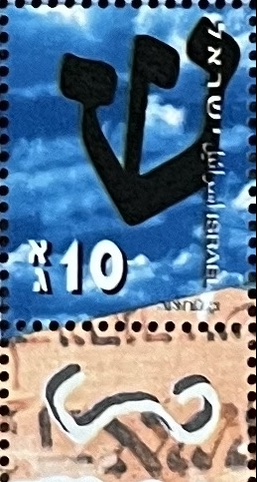
Jewish-, or block-, or square-script

In February 2001, a set of 22 stamps designed by Yitzhak Granot and E. Lorentsov was issued, each stamp illustrating a Hebrew letter, and a separate set of five representing ‘end forms’ of the letters. The stamps were issued in two separate miniature sheets. Each stamp had a value of 0.10 NIS.
The first few Hebrew letters represented in the sets were looked at in February 2024, then more In March, and the final group here in April 2024.

The modern form of Hebrew – as described in the February post, I. The Hebrew Alphabet – emerged during the 19th century, and worked on by Eliezer Ben-Yehuda (1858-1922). Hitherto, Hebrew had served as the primary vehicle of Jewish scripture, liturgy, and law.

The revival of Hebrew as a modern language had been intimately connected with the revival of the dormant Jewish nation. Hebrew became transformed into a vehicle for modern intellectual activity, and in the 20th century when Zionism moved from Europe to Ottoman then British Palestine, Hebrew became the language of the Jewish community there (the Yeshuv).

While Theodor Herzl (1860-1904) had been skeptical about whether people would ever be able to ask for a railway ticket, say, in Hebrew, the ancient language did become a daily living language. It was used not only to buy railway tickets but to negotiate with shopkeepers, and curse political opponents.

In 1948, when the State of Israel was founded, Hebrew became the official language of the new country, alongside Arabic, and English, with a state-sponsored language academy to guard its integrity. The Academy of the Hebrew Language was founded in 1953. It replace the Hebrew Language Committee founded by Ben-Yehuda in 1890.

The Academy of the Hebrew Language is located at the Hebrew University, Ramat Gan Campus. The Academy sets standards for modern Hebrew grammar, orthography, transliteration, and punctuation based on the historical development of the language. It also writes a Hebrew Historical Dictionary.

From a historical perspective, it could be argued that one of Zionism’s greatest achievements was the transformation of Hebrew into a language spoken by millions, and the creation of a world-class literary culture, boating outstanding prose writers and poets.

Among these were: author Yosef Hayim Brenner (1881-1921), born in Ukraine, died in Tel Aviv-Yafo; poet Chaim Nahman Bialik (1873-1934), born in Volhynia (now part of Ukraine and Belarus), died in Vienna, Austria; poet Rachel Bluwstien (1890-1931), born Saratov, Russia, died in Tel Aviv-Yafo; poet, author, playwright, literary translator, illustrater and painter, Leah Goldberg (1911-70), born in Königsberg, Germany (now Kaliningrad, exclave of Russia) died in Jerusalem; writer and politician S. Yizhar (1916-2006), born in Rehovot, Israel, died in Gedera, Israel; poet and translator Dahlia Ravikovitch (1936-2005), born in Ramat Gan, Israel, died in Tel Aviv-Yafo; poet Yehuda Amichai (1924-2000), born in Würzburg, Germany, died in Israel; writer and novelist Amos Oz (1939-2018), born in Jerusalem, died in Tel Aviv-Yafo; and, author David Grossman (born 1954), born in Jerusalem.

Validation of the excellence of Hebrew letters came in 1966 when one of the greatest of Israeli novelists and poets, Shmuel Yosef Agnon (1887-1970), born in Ukraine, died in Jerusalem, was awarded the Nobel Prize for literature, sharing it with German-Swedish poet and playwright Nelly Sachs (1891-1970), born in Berlin, died in Stockholm.

These men and women were Jews of central and eastern European origin, and pillars of Jewish culture in Israel. Occupying a different space were Jews of Spanish and Middle Eastern origin. Among these were: writer and civil servant Eli Amir (born 1937), born in Baghdad, Iraq; author Sami Michael (born 1926), born in Baghdad; novelist and essayist A. B. Yehoshua (1936-2022), born in Jerusalem, died in Tel Aviv; author Orly Castel-Bloom (born 1960), born in Tel Aviv; Ronit Matalon (1959-2017), born in Ganei Tikva, died in Haifa; and, rabbi and author Haim Sabato (born 1952), born in Cairo. They grew up in Ladino (a form of Judeo-Spanish), French, and Arabic environments.

One of Israel’s most accomplished writers, Samir Naqqash (1938-2004), born in Baghdad, died in Petah Tikva, won a wide and admiring literary audience throughout the Middle East for his literary work in the Arabic of his native Baghdad.

In the creation of this third and final post around the Hebrew Alphabet, the following resources were used: (1) the website of the Israel Philatelic Federation; (2) David N. Meyers, Jewish history. A very short introduction, pp. 69-71 (Oxford University Press, 2017).

If you have enjoyed this month’s post, you can access the first two in the three-part series here: I. The Hebrew Alphabet, and II. The Hebrew Alphabet.